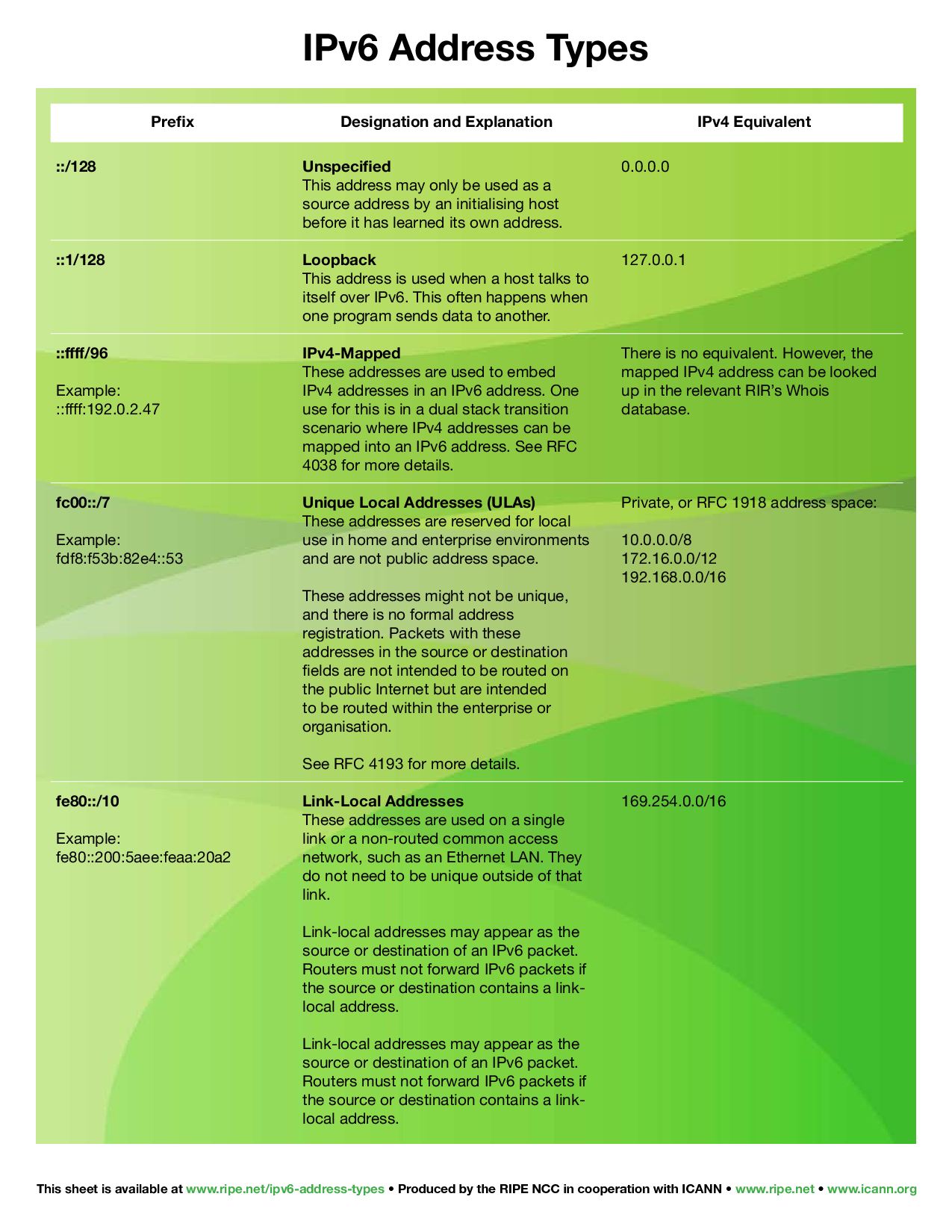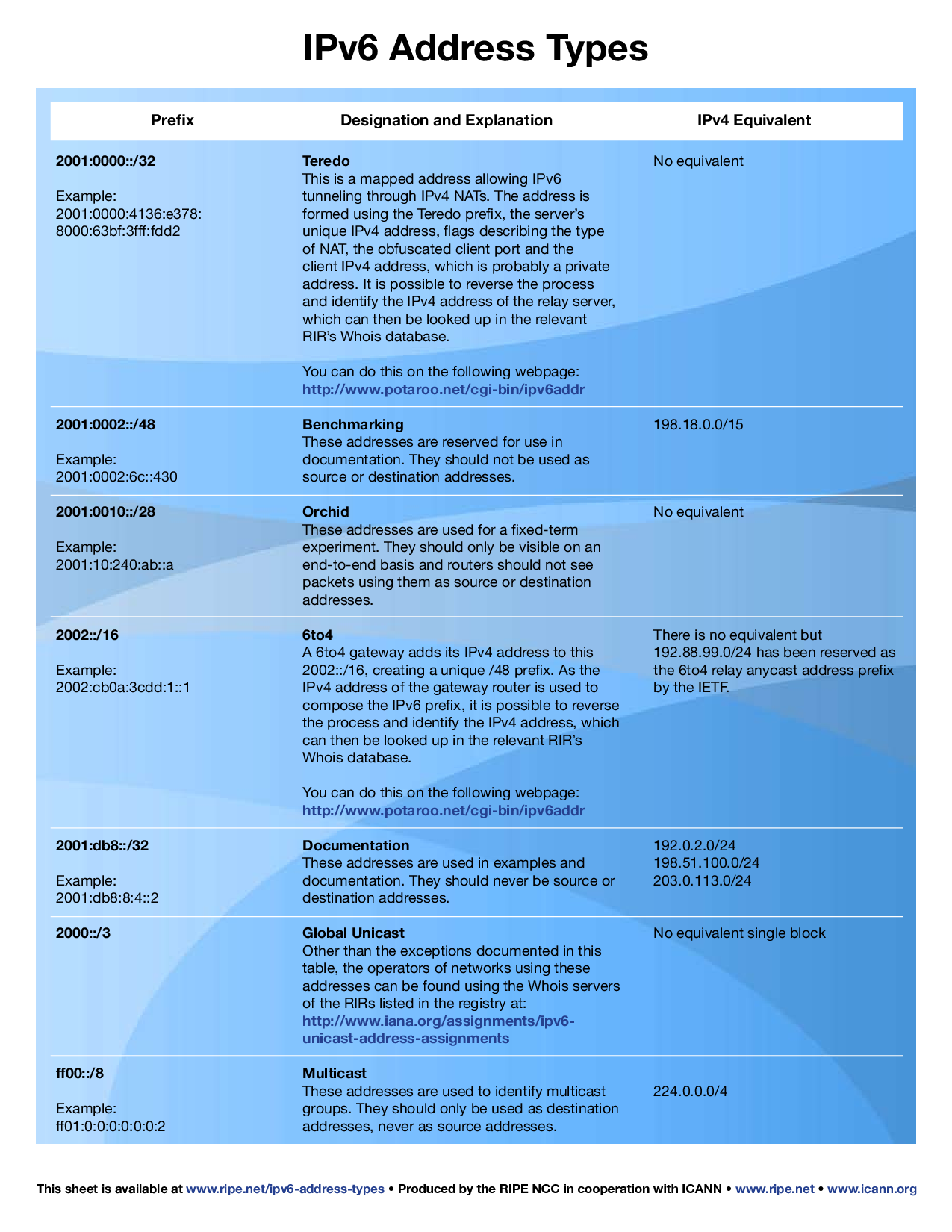:: MENU ::
Главная
Looking Glass list
Online Nettools
Online IP Subnet Calculator
Online BGP tools
Основы маршрутизации
BGP протокол
OSPF протокол
Рук-во Quagga
Cisco команды
Ваш IP и провайдер
Файлы
Книги
Полезные ссылки
Советы
Unix ToolBox
IPv4 address space
IPv6 address space
CIDR IPv4
IPv6 prefixes
PPTP / PPPoE
Измерение скорости
Форум / Forum
Статьи (блог)
Контакты
Братья по разуму
github
IPv6 Address Types


Source-specific multicast
The 232.0.0.0/8 (IPv4) and FF3x::/32 (IPv6) block is reserved for use by source-specific multicast.
Multicast addresses in IPv6 have the prefix ff00::/8. IPv6 multicast addresses are generally formed from four bit groups, illustrated as follows:
| Bits | 8 | 4 | 4 | 112 |
|---|---|---|---|---|
| Field | prefix | flags | scope | group ID |
The prefix holds the binary value 11111111 for any multicast address. Currently, 3 of the 4 flag bits in the flags field are defined; the most-significant flag bit is reserved for future use. The other three flags are known as R, P and T.
| Bit | Flag | 0 | 1 |
|---|---|---|---|
| 0 (MSB) | (Reserved) | (Reserved) | (Reserved) |
| 1 | R (Rendezvous) | Rendezvous point not embedded | Rendezvous point embedded |
| 2 | P (Prefix) | Without prefix information | Address based on network prefix |
| 3 (LSB) | T (Transient) | Well-known multicast address | Dynamically assigned multicast address |
Similar to unicast addresses, the prefix of IPv6 multicast addresses specifies their scope, however, the set of possible scopes is different. The 4-bit sc (or scope) field (bits 12 to 15) is used to indicate where the address is valid and unique.
| IPv6 address | IPv4 equivalent | Scope | Purpose |
|---|---|---|---|
| ff00::/16-ff0f::/16 | Reserved | ||
| ffx1::/16 | 127.0.0.0/8 | Interface-local | Packets with this destination address may not be sent over any network link, but must remain within the current node; this is the multicast equivalent of the unicast loopback address. |
| ffx2::/16 | 224.0.0.0/24 | Link-local | Packets with this destination address may not be routed anywhere. |
| ffx3::/16 | 239.255.0.0/16 | IPv4 local scope | |
| ffx4::/16 | Admin-local | The smallest scope that must be administratively configured. | |
| ffx5::/16 | Site-local | Restricted to the local physical network. | |
| ffx8::/16 | 239.192.0.0/14 | Organization-local | Restricted to networks used by the organization administering the local network. (For example, these addresses might be used over VPNs; when packets for this group are routed over the public internet (where these addresses are not valid), they would have to be encapsulated in some other protocol.) |
| ffxe::/16 | 224.0.1.0-238.255.255.255 | Global scope | Eligible to be routed over the public internet. |
The service is identified in the 112-bit Group ID field. For example, if ff02::101 refers to all Network Time Protocol (NTP) servers on the local network segment, then ff08::101 refers to all NTP servers in an organization's networks. The Group ID field may be further divided for special multicast address types.
The following table is a partial list of well-known IPv6 multicast addresses that are registered with the Internet Assigned Numbers Authority (IANA).
| Address | Description |
|---|---|
| ff02::1 | All nodes on the local network segment |
| ff02::2 | All routers on the local network segment |
| ff02::5 | OSPFv3 All SPF routers |
| ff02::6 | OSPFv3 All DR routers |
| ff02::8 | IS-IS for IPv6 routers |
| ff02::9 | RIP routers |
| ff02::a | EIGRP routers |
| ff02::d | PIM routers |
| ff02::16 | MLDv2 reports (defined in RFC 3810) |
| ff02::1:2 | All DHCP servers and relay agents on the local network segment (defined in RFC 3315) |
| ff02::1:3 | All LLMNR (Link-local Multicast Name Resolution) hosts on the local network segment (defined in RFC 4795) |
| ff05::1:3 | All DHCP servers on the local network site (defined in RFC 3315) |
| ff0x::c | Simple Service Discovery Protocol |
| ff0x::fb | Multicast DNS |
| ff0x::101 | Network Time Protocol |
| ff0x::108 | Network Information Service |
| ff0x::114 | Used for experiments |


